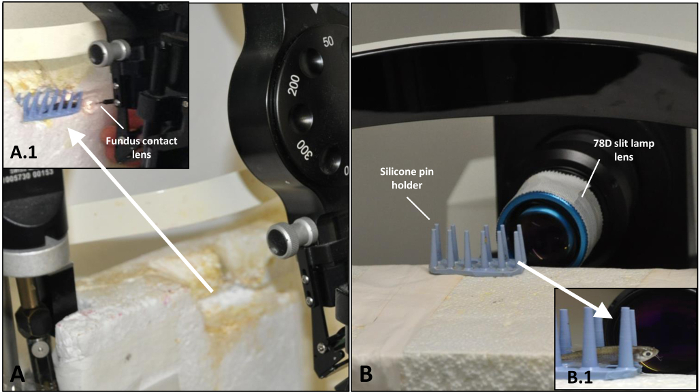このコンテンツを視聴するには、JoVE 購読が必要です。 サインイン又は無料トライアルを申し込む。
Modeling Retinal Degeneration and Regeneration in Zebrafish Using a Focal Laser Injury
Overview
This video demonstrates a procedure to induce retinal degeneration in adult zebrafish using laser injury. The laser targets photoreceptor cells in the retina, triggering cell death and a degenerative process. This damage activates Müller glia (MG) cells, leading to their dedifferentiation into stem cell progenitors that aid in retinal regeneration.
プロトコル
All procedures involving animal models have been reviewed by the local institutional animal care committee and the JoVE veterinary review board.
1. Animals
- Maintain TgBAC (gfap:gfap-GFP) zebrafish 167 (AB) strain aged between 6 - 9 months under standard conditions in water with a temperature of 26.5 °C and a 14/10 h light/dark cycle.
2. Reversible Systemic Anesthesia
- Prepare the stock solution of ethyl 3-aminobenzoate methanesulfonate salt (tricaine) by dissolving 400 mg of tricaine powder in 97.9 mL of tank water and 2.1 mL of 1 M of Tris buffered saline (TBS). Adjust to pH 7.0 with 1 M Tris (pH 9) and store at 4 °C in the dark up to one month.
NOTE: Tricaine should be prepared in water like the natural living conditions of the animal, preferably original tank water should be used. - Dilute the stock solution to 1:25 in tank water and use immediately.
- Place the zebrafish into a 10 cm Petri dish containing 50 mL of anesthesia solution until they become immobile and do not respond to external stimuli (approximately 2 - 5 min, depending on weight and age).
- Transfer each fish by hand to a custom-made silicone pin holder for laser treatment (Figure 1A).
CAUTION! The fish can remain anesthetized outside of the tank for up to 10 min only. - To reverse anesthesia after the treatment and/or imaging, place the zebrafish in container containing tank water.
- To support recovery, create a flow of fresh tank water over the gills by moving the zebrafish back and forth in the water.
3. Laser Focal Injury on Retina
NOTE: A 532 nm diode laser is used to create focal light damage on the retina of the zebrafish. The experimental set-up of the laser enables the establishment of a reproducible focal retinal injury in adult zebrafish.
- Set up the output power of the laser: 70 mW; aerial diameter: 50 µm; pulse duration: 100 ms.
CAUTION! The use of laser light requires appropriate personal protection and labelling of the area. - Apply 1 - 2 drops of 2% hydroxypropylmethylcellulose topically in the eye before treatment and use a 2.0 mm fundus laser lens to focus the laser-aiming beam on the retina.
CAUTION! hydroxypropylmethylcellulose drops are viscous and may cause problems in breathing if it goes on the gills. - Place four laser spots around the optic nerve on the left eye and use the right, untreated eye as internal control.
結果

Figure 1: Setup for the induction of the laser injury of zebrafish retina and following OCT analysis. (A) Arrangement of the laser system before treatment. (A.1) Zebrafish placed on silicone pin holder with fundus contact lens in place just prior to application of the laser beam. (B) Arrangement of the OCT system before imaging. (B.1)
開示事項
資料
| Name | Company | Catalog Number | Comments |
| Hydroxypropylmethylcellulose 2% | OmniVision, Neuhausen, Switzerland | n.a. | Methocel 2% |
| Ethyl 3-aminobenzoate methanesulfonate | Sigma-Aldrich, Buchs, Switzerland | A5040 | Tricaine, MS-222 |
| Visulas 532s | Carl Zeiss Meditec AG, Oberkochen, Germany | n.a. | 532 nm laser |
| Silicone pin holder | Huco Vision AG Switzerland | n.a. | Cut by hand from silicone pin mat of the sterilization tray accordingly. |
| TgBAC (gfap:gfap-GFP) zf167 (AB) strain | KIT, Karlsruhe, Germany | 15204 | http://zfin.org/ZDB-ALT-100308-3 |
| Tris buffered saline (TBS) | Sigma-Aldrich, Buchs, Switzerland | P5912 | |
| Ocular fundus laser lens | Ocular Instruments, Bellevue, WA, USA | OFA2-0 |
This article has been published
Video Coming Soon
Source: Conedera, F. M., et al. Müller Glia Cell Activation in a Laser-induced Retinal Degeneration and Regeneration Model in Zebrafish. J. Vis. Exp. (2017).
Copyright © 2023 MyJoVE Corporation. All rights reserved